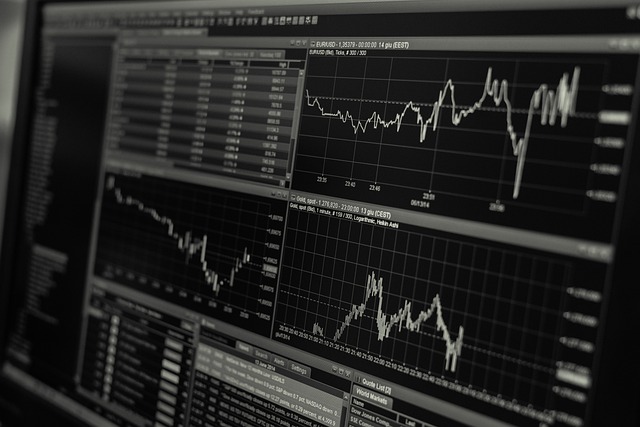How to Get Renko Charts on TradingView: A Comprehensive Guide for Traders
Author: Jameson Richman Expert
Published On: 2025-08-17
Prepared by Jameson Richman and our team of experts with over a decade of experience in cryptocurrency and digital asset analysis. Learn more about us.
Getting Renko charts on TradingView is an essential skill for traders aiming to refine their technical analysis by filtering out market noise and emphasizing pure price movements. Renko charts, originating from Japan, have become a favorite among traders globally due to their straightforward visual representation, ability to highlight trends, and capacity to reduce false signals. Unlike traditional time-based charts such as candlesticks, bars, or line charts, Renko charts focus solely on price action, constructing bricks or blocks only when the price moves by a predefined amount. This distinctive methodology makes it easier to identify high-probability trade setups, trend reversals, and breakouts. Mastering how to access, customize, and interpret Renko charts on TradingView can dramatically improve your trading decisions, especially in volatile markets like cryptocurrencies, forex, and equities. This in-depth guide covers step-by-step instructions, advanced customization techniques, strategic integration tips, and best practices to leverage Renko charts effectively within your trading arsenal.

Understanding Renko Charts and Their Key Benefits
Renko charts are a unique charting technique that strips away the time dimension, concentrating solely on price movement. They are built from bricks—each representing a fixed price move—that are added only when the price exceeds the previous brick by the set brick size. During periods of low volatility or consolidation, no new bricks form, which helps smooth out minor fluctuations—market noise that often leads to false signals on traditional charts. Conversely, during strong trending conditions, bricks accumulate rapidly, providing a clear visual of the trend’s strength and direction.
The advantages of Renko charts include:
- Enhanced Trend Clarity: By filtering out insignificant fluctuations, Renko charts provide a cleaner view of the underlying trend, making it easier to identify sustained price movements and avoid reacting to fleeting market noise.
- Precise Support and Resistance Levels: Brick formations naturally highlight significant support and resistance zones. These levels are critical for setting stop-loss orders, entry points, and profit targets with higher confidence.
- Early Reversal and Breakout Detection: Changes in brick color or pattern formations—such as multiple bricks in the same direction—can signal potential reversals or breakouts, often earlier than traditional chart types.
- Superior Noise Filtering in Volatile Markets: Assets like cryptocurrencies, forex, and commodities often experience erratic price swings. Renko charts help traders focus on meaningful moves, reducing the risk of false signals caused by short-term volatility.
- Improved Entry and Exit Timing: Their simplicity and trend emphasis aid traders in timing entries and exits more systematically, reducing emotionally driven decisions triggered by short-term market chatter.
Integrating Renko charts into your technical analysis fosters a more disciplined, trend-following approach. They assist in minimizing emotional trading, enhancing signal quality, and developing strategies tailored for trending markets. When used correctly, Renko charts can be a game-changer in your trading toolkit, especially when combined with other indicators and analysis techniques.
Step-by-Step: How to Access Renko Charts on TradingView
TradingView’s platform is renowned for its versatile and user-friendly charting tools, including seamless access to Renko charts. Follow these detailed steps to incorporate Renko into your trading workflow:
- Create or Log Into Your TradingView Account: Visit TradingView's official website. Register for a free account or log in if you already have one. While free accounts provide a robust set of features, access to advanced chart types like Renko generally requires a paid subscription (Pro, Pro Plus, or Premium). Upgrading unlocks additional benefits such as multiple indicators, multiple chart layouts, faster data refreshes, and dedicated customer support.
- Open a New Chart: Use the search bar at the top to find the asset you wish to analyze—be it a cryptocurrency, stock, forex pair, or commodity. Click on the desired instrument to load its detailed chart interface.
- Access Chart Type Settings: On the main toolbar at the top, locate the current chart type icon (commonly showing candlestick, line, or bar charts). Click this icon to open a dropdown menu with various chart styles.
- Select "Renko" from the List: Scroll through the available options and click on "Renko." If you do not see it listed, verify your subscription plan—Renko is typically available on paid tiers. If necessary, consider upgrading your plan for full access.
- Configure Brick Size and Settings: After selecting Renko, click the gear icon (the settings button) on the chart. In the settings window, navigate to the "Symbol" tab where you can set your preferred brick size. You can choose a fixed brick size or opt for "Automatic," which adjusts dynamically based on market volatility. Setting the correct brick size is crucial: smaller bricks (e.g., 1-2 units) are more sensitive and suitable for highly volatile assets, while larger bricks (e.g., 10+ units) provide a smoother, less cluttered view for less volatile instruments.
Advanced Customization Techniques for Effective Renko Analysis
To truly harness the power of Renko charts, fine-tuning your settings based on the asset, timeframe, and your trading style is essential. Here are advanced tips to optimize your Renko setup:
- Experiment with Brick Sizes: Use backtesting or volatility metrics such as the ATR (Average True Range) to determine optimal brick sizes. For highly volatile assets like cryptocurrencies, smaller bricks (1-5 units) help capture quick moves, while larger bricks (10-20 units) help avoid over-sensitivity in stable markets.
- Utilize ATR-Adjusted Brick Sizes: Implement an adaptive approach by setting brick sizes relative to ATR values. For instance, choosing a brick size of 1.5x ATR ensures the chart dynamically responds to volatility changes, providing a balanced view that prevents overreaction or sluggishness.
- Overlay Moving Averages and Trend Indicators: Applying overlays such as the 50- or 200-period Moving Average over your Renko chart can help confirm trend direction, filter false signals, and facilitate trend-shift identification.
- Combine Momentum Oscillators and Volume Indicators: Use tools like RSI, MACD, or volume analysis to validate signals generated by Renko bricks. For example, ascending bricks supported by RSI bullish divergence reinforce the likelihood of trend continuation.
- Backtest Multiple Configurations: Regularly test different brick sizes, indicator overlays, and timeframes. Conduct historical testing to identify the most effective combinations tailored to your trading style and the specific markets you trade.

Strategic Integration: How to Incorporate Renko Charts Into Your Trading Approach
For maximum effectiveness, integrate Renko charts within a comprehensive analytical framework. Here are strategies to embed Renko analysis into your trading routine:
- Trend Confirmation: Rely on the series of consecutive bricks in the same direction to confirm trend strength. Multiple ascending or descending bricks suggest a robust trend, whereas conflicting brick patterns may signal consolidation or potential reversals.
- Early Reversal and Breakout Signals: Detect brick color changes or formations like "double bricks" (two bricks of the same color) as signs of momentum buildup. Breakouts beyond previously established brick highs or lows—especially when confirmed by other indicators or volume—can signal significant upcoming price movements.
- Hybrid Chart Strategies: Combine Renko with traditional chart types like candlesticks or Heikin-Ashi to validate signals. For instance, a series of Renko bricks indicating an upward trend confirmed by bullish candlestick patterns offers higher confidence for entries.
- Identify Support and Resistance with Brick Patterns: Use brick formations to locate and reinforce key support and resistance zones, aiding in stop-loss placement and profit targets. Relying on these levels enhances risk management and trade discipline.
- Risk and Money Management: Set stop-loss orders beyond the last brick or at critical pivot points identified through brick formations. This clear, rule-based approach reduces emotional reactions and improves trade consistency.
The key is to blend Renko signals with other technical tools and market context, ensuring your trading decisions are disciplined, well-informed, and adaptable to changing conditions.
Additional Resources, Platforms, and Tools to Enhance Your Renko Trading
While TradingView provides a comprehensive environment for Renko charting, supplementing your analysis with additional resources can boost your proficiency:
- CryptoTradeSignals — Offers real-time market insights, detailed technical analysis, and alerts that complement Renko-based strategies, especially in crypto markets.
- Top Trading Platforms in India — Reviews of platforms supporting advanced chart types like Renko, tailored for regional traders.
- XRP and Crypto Analysis — Deep dives into specific cryptocurrencies, helping traders combine fundamental insights with technical signals.
- Market Cycles & Indicators — Guides to technical tools that work synergistically with Renko, such as oscillators, volume analysis, and pattern recognition.
Final Tips and Best Practices for Effective Renko Trading
- Consistent Testing and Optimization: Regularly experiment with brick sizes, indicator overlays, and timeframes. Backtest your setups to ensure they adapt to evolving market conditions.
- Adjust for Market Volatility: Proactively modify brick sizes based on volatility metrics—smaller during sideways or choppy markets, larger during strong trending phases—to maintain signal relevance.
- Develop a Rigid Trading Plan: Define clear rules for entries, exits, and risk management based on Renko signals. Discipline prevents impulsive trading and emotional decision-making.
- Engage with Educational Content and Communities: Participate in webinars, trading forums, and tutorials focused on Renko strategies. Sharing insights accelerates learning and adaptation.

Conclusion
Mastering the integration of Renko charts within TradingView empowers traders with a powerful tool to identify trends, reversals, and breakouts with greater clarity. Their ability to filter out noise, highlight significant price movements, and simplify complex data makes them invaluable for trend-following and breakout strategies. From initial setup and customization to advanced analysis and strategic deployment, continuous learning and iterative testing are key. Use the detailed steps and expert tips provided here to incorporate Renko charts into your daily trading routine, refining your approach and boosting profitability. Remember, successful trading hinges on adaptability, disciplined execution, and rigorous analysis. To deepen your knowledge and stay ahead in dynamic markets, explore additional resources like CryptoTradeSignals and actively participate in trading communities for ongoing growth.